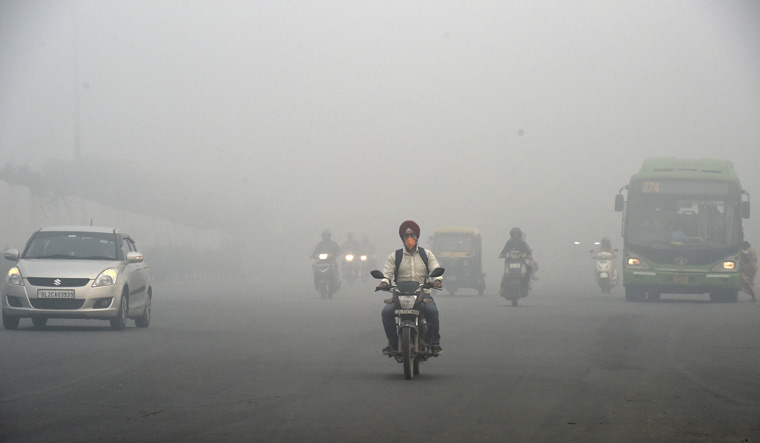Delhi’s Air Quality Needs Data-Driven Action
Oct 12, 2023 | Pratirodh Bureau
Vehicles ply amid low visibility due to a thick layer of smog in New Delhi (Image: PTI)
The issue of Delhi’s poor air quality resurfaces episodically in the public consciousness. It garners attention on social media, in newspapers and in scientific studies, largely during the winter months. During this period, Delhi’s air quality index (AQI) drops from ‘poor’ to ‘severe’, across most monitoring stations.
The World Health Organization (WHO) recommends air quality standards with limits on air pollutant concentration, crossing which can be harmful to humans. Particulate Matter 2.5 (PM 2.5), a pollutant measuring less than 2.5 microns in size, has the capacity to traverse the respiratory system and enter the bloodstream, adversely impacting human health. During the 2021-22 period, the city reported an average PM2.5 concentration of 100 μg/m3, surpassing the WHO’s recommended limit of 5 μg/m3 by a factor of 20, which can result in severe effects on health. To ensure the well-being of our cities, effective and efficient air quality management is a necessity.
The State of Air Quality Data
Effective air quality management in metro cities requires four significant steps: First, monitoring air quality and gathering data specific to the city; second, identifying the sources of pollution, analyzing the factors that affect it and assessing the impact of pollutants; third, formulating policies based on the data from steps one and two; and fourth, robust implementation of integrated policies. In the case of Delhi, steps one and two have been adequately addressed, while step three has been implemented to a certain extent.
Delhi has 40 Continuous Ambient Air Quality Monitoring Stations (CAAQMS) and 10 National Air Monitoring Programs (NAMP). Twenty six percent of its population resides within a 2-km radius while 100% of the population is covered within a 50-km radius of the monitoring network. This is higher than any megacity in India and excludes private research monitoring stations. It is safe to say that there is no dearth of air quality data for Delhi.
Since 1997, 11 detailed studies on pollutant source contribution have been conducted in Delhi. These studies indicate that Delhi’s air pollution is primarily from sources such as transport, industries, residential cooking, waste management and burning, construction, road dust and the lighting of firecrackers.
Existing Policy Initiatives
The Union Government’s Graded Response Action Plan (GRAP), the National Clean Air Programme (NCAP) and the Commission for Air Quality Management (CAQM) were developed to address Delhi’s air pollution. The Fifteenth Finance Commission Grant (XVFC) is also being used to finance mitigation strategies to combat air pollution in the city. Under these programs, several policy initiatives have been implemented that have helped with managing air pollution from some sectors.
Replacing diesel engines in buses with compressed natural gas (CNG) and encouraging electric vehicle use by providing incentives – including offering scrappage of old vehicles, loan subsidies, discounts at charging stations, road tax exemptions and registration fee reductions – were some key initiatives. In 2022, Delhi had over 160,000 electric vehicles on the road with the Delhi Transport Corporation (DTC) having 150 electric buses in its fleet. In the years to come, both numbers are expected to increase with the electric bus fleet reaching 1500. The odd-even initiative also reduced traffic and air pollution during the worst months to some extent. The Delhi Metro Rail, one of the biggest public transportation systems, with a pre-pandemic ridership of 6 million, played a significant role in reducing air pollution.
In addition, Delhi implemented advanced vehicle and fuel emission standards with the introduction of Bharat Stage-VI (BS-VI), three years before its nationwide launch in 2020. In the industrial sector, no facility is permitted within NCT Delhi to use fuel other than piped natural gas (PNG), electricity or liquified petroleum gas (LPG).
While progress has been made in the transportation and industrial sectors, opportunities remain for improvement in some of the other source sectors. For instance, waste burning is an outcome of a lack of proper solid waste segregation and low awareness of its implications. Another sector that sees high emissions is the construction industry that contributes 21% and 8% of PM10 and PM2.5 respectively, followed by household cooking, waste burning and eateries. Clean construction activities are not being implemented at scale, as a result, construction activities are banned during poor air quality episodes, adversely impacting construction workers.
Way Forward: Bridging the Gaps
Delhi has an opportunity to expand its air quality management toolkit by examining best practices followed in other parts of India, specifically in construction and solid waste management. For example, the Surat Clean Air Action Plan (SCAP), under which, India’s first clean construction handbook and a pilot-level mitigation strategy for clean construction practices were prepared.
The initiative helped in collecting data on construction and in evaluating potential control measures to reduce air pollution. After a successful pilot at one site, this practice is now being replicated at various other construction sites across Surat. Another example from Surat is their waste management strategy, where open waste burning dropped from 25% in 2015 to 2% in 2020 which was found during the study conducted under SCAP.
Indore, India’s cleanest city for six years, is known for its robust solid waste management system which includes 100% waste segregation at source, door-to-door collection, and treatment of waste. Leveraging insights and experiences from Indore and Surat could significantly strengthen Delhi’s efforts to tackle air pollution.
Finally, adopting an airshed-oriented strategy is essential, not only for comprehending emission sources, but also for effectively executing policies at the grassroots level for improved outcomes. Raising awareness through public engagement and participation, coupled with a comprehensive approach encompassing all emission sources, can play a pivotal role in diminishing air pollution in the Delhi NCR region.
(Published under Creative Commons from World Resources India. Read the original article here)
